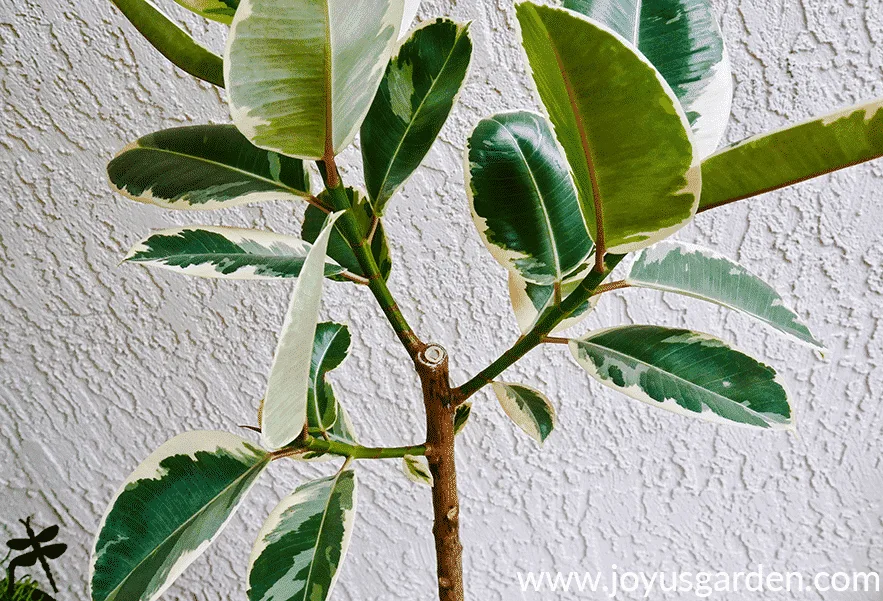How To Make A Rubber Tree Branch Out To Promote New Growth
Rubber Plants are fast growing and can quickly reach the ceiling if left unchecked. If your plant is getting too tall, looking leggy, or simply needs a refresh, pruning can give it a whole new look. Many don’t realize you can transform a skinny Rubber Tree into a fuller, more tree-like form. Here’s how to make a Rubber Tree branch out to keep it healthy and beautiful.
Botanical Name: Ficus elastica Common Names: Rubber Tree, Rubber Plant, Rubber Fig, Indian Rubber Tree
Note: This was published on 6/6/2019. It was updated on 10/11/2024.

Rubber Tree Branching Out Guide
How Does a Rubber Tree Plant Branch?
Rubber Trees don’t naturally branch out. As shown in the photo above, they grow as a single stem with foliage up and down. However, one of the best ways they can be trained to side branch is by pruning.
When I first graduated from college, I worked in the houseplant trade. Growers label plants with leaves all the way up and down as “full to base.” Plants with a trunk and foliage at the top are labeled “standard” (tree form).
A Rubber Tree branches out as a result of being pruned. You can either leave the leaves on the main stem or remove them so the plant becomes more of a tree form with an exposed trunk.
As I’m rewriting this post, one of mine is about to hit the ceiling in my kitchen (you’ll see it a few photos down). I’ll let this one be, and it’ll grow across the ceiling. I’ve seen a very large one growing this way, and I don’t mind the look. I have a smaller, 6′ Variegated Rubber Tree standard growing in my dining room that I won’t let get above 8′. I’ll do prune pruning and maybe a bit of notching to keep the size in check.

When To Prune
The best time is during the active growing season, early spring through late summer.
Ways to Make Your Rubber Tree Branch Out
Note: These methods will also make your Rubber Plant fuller if it has gotten leggy.
1) Pruning the top off.
Cut the main stem straight across with clean, sharp pruners. Either compost the top or root it in a light mix or water.
I air layered mine, cutting the top off after the air layered portion had rooted. This is another very successful way to get a bushier plant and propagate it, too. After I air layered mine, the mother plant put out two side branches.
Note: If you’re pruning the top off because your plant is about to touch the ceiling, take it down by at least 12″. The new growth that turns into side branches will soon hit the ceiling, and you’ll have to prune them down, too!
2) Tip pruning. This is where you cut off the end growth, usually 1-5″.
3). Notching.
This works on plants with woody stems. I’ve done it on an apple tree, and although the technique sounds scary, it’s pretty simple. Make an angled cut (or, if you want four branches, make four cuts) directly above a node. This will force that node to put out growth and eventually turn into a branch.
Note: Make sure your Rubber Plant is getting enough light. They do best in moderate to high light. If the light levels are too low, none of these methods will produce successful results.
Are you new to growing Rubber Trees? This post on Rubber Plant care will guide you through the process.

More on Air Layering A Houseplant
Some of the other popular houseplants that air layer beautifully are Weeping Fig, Fiddle Leaf Fig, Dracaenas, Dumbcane, Umbrella Tree, Dwarf Umbrella Tree, and Split Leaf Philodendron. The two plants I’ve successfully air layered are the Dumb Cane (Dieffenbachia Tropic Snow) and Burgundy Rubber Plant (Ficus elastica Burgundy).
Air layering timeline:
I air layered the mother plant and removed the baby once it showed significant rooting.
I thought you might be interested in how long this has taken. Here’s the timeline of how this all went down:
I did the air layering at the end of April 2018. The air layered portion was cut off and planted in potting mix at the beginning of Sept. 2018. I could have done this at the end of July, but I got busy with other things!
I let the mother plant settle for a few weeks before starting to remove the leaves at the very bottom in early October.
Every 3-6 weeks, I took a couple more leaves off.
By the end of May 2019, the Rubber Tree branching was well underway and the all the leaves had been removed.

Are you interested in the air layering process? Check out propagating a Rubber Tree by air layering & how to prune off & plant an air layered stem.
A Word of Warning About Pruning A Rubber Plant
The Rubber Tree emits a milky white sap that is considered toxic to people and pets. The sap has never bothered me, but it could irritate you. If you think it’ll affect you, keeping it away from your face is a good idea. Wear gloves and long sleeves when pruning or handling a Rubber Plant. You’ll need to clean your pruners soon after.
Here’s what I do with fresh cuts: Immediately after removing any leaves, I wrap the stem with a rag ( a paper towel works) to cover the nodes where the leaves have been removed. I also wrap the leaf stem that’s been cut off.
The sap drips like crazy for about a minute or two, and this prevents it from running down the trunk of the plant, onto your skin or clothes, or on your floor. If not contained or cleaned off immediately, the sap can stain your clothing or rug.


Pruning
A few of the leaves were stubborn to come off. I used a sharp knife to start the process and then pulled them off. You want to remove as much of the leaf stem from the trunk as possible. It just looks better that way.
When the top four nodes produced new shoots, I removed the four older leaves right below those new sprouts.
I removed the leaves gradually because of the dripping sap—it was just easier for me to do it this way than all at once.
Don’t remove any leaves if you want to keep your plant full of foliage from top to bottom.
If using the notching method, you may have to prune off the top depending on where you notch your plant.
After Care
After you prune, air layer, or notch your plant, you want to put it in bright light with no prolonged direct sun. Resume care as usual and fertilize during the growing season.
Video Guide
Rubber Tree Branching FAQs
You can move it to a spot that gives it more room to grow upwards, prune, air layer, or notch it. Or, you can do as I’m doing with one of my Rubber Trees and let it grow across the ceiling.
Yes. Just be aware it’ll branch where it was cut. New branches will appear from the side shoots just below where it was cut. The best time of year to do this is during the growth season. Make sure your pruning tool is clean and sharp, and keep in mind the sap that pours out of the stem and leaves after you cut them because it could cause skin irritation.
If you have a healthy plant, you can easily air layer it. You can also cut root stems in a light mix or water. If you have a long, woody stem, you’ll want to avoid that woody section of the stem and use the younger growth for successful rooting.
I cut the top off my Rubber Tree in September after it air layered. New growth appeared in March, and branching was underway by May. You should see faster progress in the warm season.
You can use any of the methods in the “How to Make Your Rubber Tree Branch Out” chapter. Your plant may need more light, as lack of light is one of the causes of plant legginess. They do best in bright indirect light.
These plants grow fast, and their own weight can cause them to lean. The Rubber Tree in my kitchen is 10′ and has three stems, all of which are staked with sturdy 7′ bamboo stakes.
Your plant will need a bigger pot at some point. This guides you through repotting a Rubber Tree.


Conclusion: Following these simple techniques, you can transform this popular houseplant with gorgeous glossy leaves from a tall, leggy, skinny Ficus elastica into a lush, branching beauty. Whether you choose to prune, pinch, or try air layering or notching, encouraging new growth is an easy way to give your plant a fuller, more vibrant appearance. Remember to provide the right aftercare, including plenty of light and proper watering. With a little patience, your Rubber Tree will reward you with healthy, strong branches.
Happy gardening,

This post may contain affiliate links, you can read our policies here.






Very helpful and knowledgeable, as someone new to the plant addiction I enjoy your blogs and videos!
Your posts are always so informative and helpful. I come here first for information. Thank you! I plan to do this to my plant at some point!
Hi, we are coming into spring where I am and I want to do this with my ruby rubber plant. Is now a good time to start air layering?
Yes Gemma, Spring & summer are great times to air layer a plant. Nell